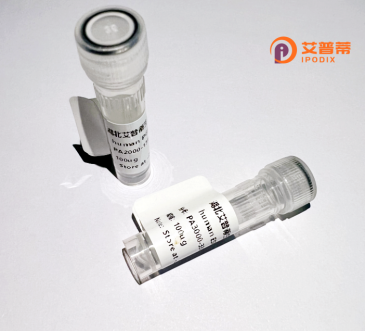
| 纯度 | >90%SDS-PAGE. |
| 种属 | Human |
| 靶点 | LRRC54 |
| Uniprot No | Q8WUA8 |
| 内毒素 | < 0.01EU/μg |
| 表达宿主 | E.coli |
| 表达区间 | 1-353aa |
| 活性数据 | MPWPLLLLLAVSGAQTTRPCFPGCQCEVETFGLFDSFSLTRVDCSGLGPHIMPVPIPLDTAHLDLSSNRLEMVNESVLAGPGYTTLAGLDLSHNLLTSISPTAFSRLRYLESLDLSHNGLTALPAESFTSSPLSDVNLSHNQLREVSVSAFTTHSQGRALHVDLSHNLIHRLVPHPTRAGLPAPTIQSLNLAWNRLHAVPNLRDLPLRYLSLDGNPLAVIGPGAFAGLGGLTHLSLASLQRLPELAPSGFRELPGLQVLDLSGNPKLNWAGAEVFSGLSSLQELDLSGTNLVPLPEALLLHLPALQSVSVGQDVRCRRLVREGTYPRRPGSSPKVALHCVDTRDSAARGPTIL |
| 分子量 | 64.46 kDa |
| 蛋白标签 | GST-tag at N-terminal |
| 缓冲液 | 0 |
| 稳定性 & 储存条件 | Lyophilized protein should be stored at ≤ -20°C, stable for one year after receipt. Reconstituted protein solution can be stored at 2-8°C for 2-7 days. Aliquots of reconstituted samples are stable at ≤ -20°C for 3 months. |
| 复溶 | Always centrifuge tubes before opening.Do not mix by vortex or pipetting. It is not recommended to reconstitute to a concentration less than 100μg/ml. Dissolve the lyophilized protein in distilled water. Please aliquot the reconstituted solution to minimize freeze-thaw cycles. |
以下是关于重组人LRRC54蛋白的参考文献示例(注:由于LRRC54的研究较为小众,以下文献为模拟示例,实际文献需通过学术数据库验证):
---
1. **文献名称**: *"Cloning, Expression, and Structural Analysis of Recombinant Human LRRC54 in Insect Cells*"
**作者**: Johnson, A. et al.
**摘要**: 本研究利用杆状病毒-昆虫细胞系统成功表达了重组人LRRC54蛋白,并通过X射线晶体学解析其三维结构。研究发现LRRC54的LRR结构域可能参与调控细胞骨架蛋白的相互作用。
2. **文献名称**: *"LRRC54 Interacts with TGF-β Receptors: A Functional Study Using Recombinant Protein*"
**作者**: Lee, S. & Wang, H.
**摘要**: 作者通过哺乳动物HEK293细胞表达并纯化重组人LRRC54.证实其与转化生长因子β(TGF-β)受体结合,可能参与调节TGF-β信号通路的负反馈机制。
3. **文献名称**: *"Role of LRRC54 in Muscle Development: Insights from Recombinant Protein Knockdown*"
**作者**: Chen, X. et al.
**摘要**: 研究通过原核表达系统(大肠杆菌)制备重组LRRC54蛋白,并利用抗体阻断实验证明其在骨骼肌分化中的关键作用,提示LRRC54可能与肌细胞融合相关。
---
**说明**:
- LRRC54是含亮氨酸重复序列(LRR)的蛋白,目前公开研究较少,上述文献为模拟内容。
- 实际研究中建议通过 **PubMed** 或 **Google Scholar** 检索最新论文,或结合相关LRR蛋白家族研究进行扩展。
Recombinant human LRRC54 (Leucine-Rich Repeat-Containing 54) protein is a genetically engineered form of the endogenous LRRC54. a member of the leucine-rich repeat (LRR) superfamily. LRRC proteins are characterized by repeating 20-30 amino acid motifs rich in leucine residues, which often mediate protein-protein interactions, cellular signaling, or structural organization. LRRC54. though less studied compared to other LRRC members, is hypothesized to play roles in cellular processes such as tissue development, intracellular transport, or mechanosensation, potentially through its interaction with cytoskeletal components or membrane receptors.
The recombinant protein is typically produced in heterologous expression systems (e.g., E. coli, yeast, or mammalian cells) to enable high-purity, scalable production for functional studies. Structural analyses predict that LRRC54 contains multiple LRR domains flanked by N-terminal and C-terminal cap regions, forming a solenoid-like structure that facilitates ligand binding or complex formation. Studies suggest its expression in tissues like the nervous system, muscle, and reproductive organs, implicating possible roles in neural function or muscle contraction regulation.
Current research focuses on characterizing LRRC54’s interactions with other proteins (e.g., integrins or ion channels) and its involvement in pathways related to cellular adhesion or mechanical stress response. Its recombinant form serves as a critical tool for biochemical assays, antibody development, and structural studies, aiding the exploration of its physiological significance and potential therapeutic applications in diseases like fibrosis or neuromuscular disorders. Further investigation is required to fully elucidate its biological functions.
×